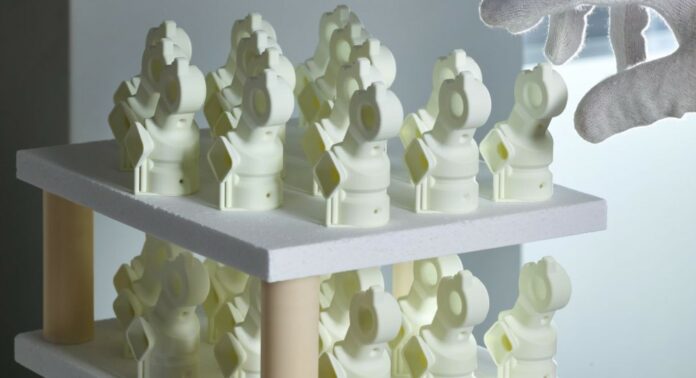Ceramic 3D printing company Admatec enhances its ceramics 3D printing production lines with a larger integrated debinding and sintering furnace. The ultimate goal of the machine manufacturer is to enable customers to achieve mass production.
The OEM recalls that the printing process of technical ceramics requires a machine that can handle high viscosity slurries. To enable this, 2013 saw the development of a printing process which combines tape casting (for slurry depositioning) with Digital Light Processing (UV curing using stereo lithography) within Admatec’s portfolio.
The period coincides with the development of lithography based ceramic additive manufacturing technologies and systems that feature typical projection areas of 96×54 mm at a resolution of 50 µm. Debinding and sintering was then, executed in two separate furnaces, resulting in a thermal process of almost 2 weeks.
To improve this process, and thus achieve efficient serial production, Admatec developed larger printing machines, with projection areas that could reach up to 260×220 mm in one single machine.
The DLP printing process which cures a next layer of a full build platform in a few seconds, in combination with tape casting to deposit a new slurry layer, allows to increase printing speeds up to 300 layers per hour. In the same vein, materials have been optimised for faster debinding times and higher final density and mechanical properties.
Over time, it seemed natural to the company to enhance the debinding and sintering process as well, hence the development of a compact integrated debinding and sintering furnace in 2018. Specially designed for post-processing of 3D printed technical ceramics, this furnace allows safe, controlled debinding and accurate sintering with excellent temperature uniformity. With a useful volume of 180x180x200 mm and maximum temperature of 1700°C, this furnace is a cost-effective and efficient solution to debind and sinter small parts printed in oxide ceramics.
However, with machines that deliver a printing build volume of 260x220x500 mm, it’s important to provide larger debinding and sintering machines that could simplify the production steps which is why the new integrated debinding and sintering furnace provides an inner volume of 400x400x400 mm.
“All these improvements, in combination with specially designed integrated debinding and sintering furnaces, currently allow to produce a set of 3D printed technical ceramic parts, from CAD design till sintered end-use part, in less than 7 days. With a maximum temperature of 1700°C and useful inner volume of 64 litres, the new furnace has almost 10 times the size of the compact integrated furnace, dramatically increasing the throughput and efficiency in technical ceramic 3D printing and postprocessing”, the company says.
Remember, you can post job opportunities in the AM Industry on 3D ADEPT Media free of charge or look for a job via our job board. Make sure to follow us on our social networks and subscribe to our weekly newsletter : Facebook, Twitter, LinkedIn & Instagram ! If you want to be featured in the next issue of our digital magazine or if you hear a story that needs to be heard, make sure to send it to contact@3dadept.com






